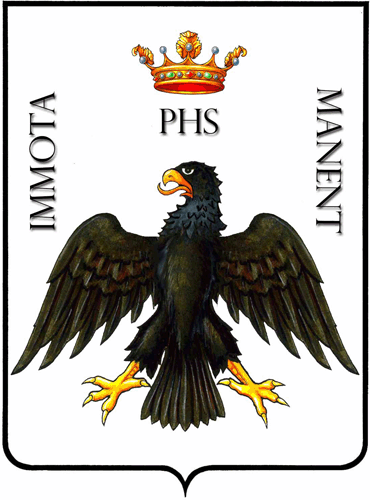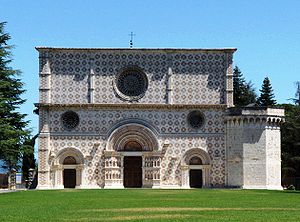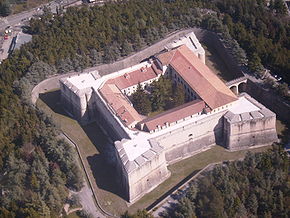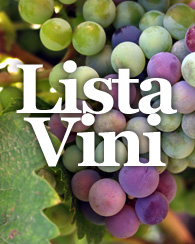
L'Aquila | |||||
| | |||||
Saint Maximus of Aveia | |||||
| Saint Maximus of Aveia is worshiped as a martyr, like very many saints from the initial times of Christianity. He was born around the year 228 in Aveia (now Fossa), near L'Aquila. Born in a Christian family, he wished to become a priest and professed his faith even before the prefect of Aveia, after being imprisoned during the emperor Decius's persecution against Christians. He was long tortured in order that he abjured, with no results. It seems that he was even offered the governor's daughter as a wife but Massimo refused. Finally, they killed him by throwing him down from the highest rock of Aveia. 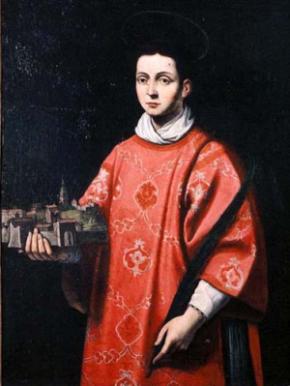 In 1256 his relics were brought to the newly founded L'Aquila and since then Saint Maximus is the city's patron. | |||||
The patron saint celebration | |||||
| Saint Maximus's feast is celebrated every year with a solemn mass in the cathedral of Saint Maximus, but the most important event that takes place in L'Aquila is the celebration of the Perdonanza Celestiniana (Celestine's Forgiveness), established by the co-patron saint of L'Aquila Saint Peter Celestine (also called Saint Peter from Morrone or saint Pope Celestine V). Peter from Morrone was a friar who had spent most of his life living as an hermit in a cave on the Abruzzi mountains, first on the mount Morrone and then on the Majella. He was already well known in Europe among sovereigns and to the pope as a man of holiness. He had gathered other hermits around himself and founded the community that later would be called the Order of Celestines. He even went on foot to Lyon to meet the pope during the council to prevent the suppression of his order. Elected pope in 1294, after over two years of conclave and after the conclave itself had received from him a reproach letter because they had been deferring the election of the new pope, was crowned in L'Aquila. He was nearly eighty. At first he tried to refuse, but then he accepted the nomination. He suddenly passed from his hermitage to finding himself in the middle of all political affairs, under the influence of the king of Naples Charles II, and power matters within the church, being controlled by cardinal Benedetto Caetani, the future pope Boniface VIII. So, probably realising he was being manoeuvred, he renounced the office of pope after only four months. Less than two weeks after his renunciation, the conclave elected a new pope, the cardinal Benedetto Caetani himself. Celestine wanted to go back to his hermitage, something that cardinal Caetani had promised him. Instead he had him arrested and kept him secluded in a castle property of the Caetanis, where he died about a year later. The Perdonanza CelestinianaAfter only one month from his election, Celestine V carried out his most important official act for which we still remember him: he issued a document called the Bolla della Perdonanza (the Bull of Forgiveness) that granted plenary indulgence to anyone (repented and confessed) enters the basilica of L'Aquila between the evening of the 28th and that of the 29th of August.This bull is still valid and its commemoration is both a civic and religious event, with the mayor reading the text of the bull of forgiveness before the opening of the holy gate. Every year since then, the grant of the indulgence is celebrated. This is preceded by a week of religious and cultural events, conventions, shows, a historical procession with flag-wavers, concerts. In the following video you can get an idea of the celebrations. They are really touching moments, especially the night shows with the scenery of the Basilica of Collemaggio, that you can see in the video. Don't miss the opportunity to visit another one of Italy's jewels! | |||||
| |||||
| L'Aquila is the region capital of the Abruzzi, that has the 28% territory protected, included in parks: the National Park of Abruzzo, the National Park of Gran Sasso and Laga Mounts, the National Park of Majella, the Regional Parco Sirente-Velino. Its altitude is 721 metres above the sea level and has about 70,000 inhabitants. Thanks to its inland location in the region and surrounded by mountains, the weather in L'Aquila is quite cool in summer, with noticeable differences in temperature between day and night and definitely cold in winter. | |||||
L'Aquila is an ancient city, whose construction was started by Frederick II, emperor of the Holy Roman Empire, concluded in 1254. It is a city rich in culture and monument.
Spanish Castle, built in the 16th century on the ruins of a small fortress, still preserves the angular towers and the moat and is surrounded by a large park. The castle houses the Museo Nazionale d'Abruzzo (National Museum of Abruzzo) with the paleontology sections including, among the other interesting things, the skeleton of a fossil prehistoric elephant found in the area. I myself have been able to admire it and it's really impressive for its size, it's over 4 metres (13 ft) high and over 6 metres (19 ft) long!
Around L'Aquila you can do excursions in the parks and admire animals (with a bit of luck and by respecting the environment avoiding noises) and vegetation. L'Aquila landscapes, thanks to their beauty, have been the scenery of many movies too. Here you can immerse yourself in the nature and enjoy a walk on the footpaths. The most imposing representative of the local fauna is the marsican bear, a type of bear of the Apennines, of a relatively smaller size. There are also some Apennines wolves. Other important mammals of the National Park of Abruzzo are the wild cat, the wild boar, the fallow deer and the roe deer. Also well common in the area marsican in part of the National Park of Abruzzo is the chamois. Among birds of prey it's worth mentioning the golden eagle, the hawk, the buzzard and the sparrowhawk. There are also the Alpine chough and the woodpecker and among reptiles, the vipera. It lives in stony grounds near water courses and in areas with low juniper bushes. Once we know it, we can avoid them! There are many thickets of poplar trees, hornbeams and of Turkey oaks, and also hazels, chestnuts (great opportunity in autumn to pick up a lot of fruits), maples (often with some gigantic specimen), black pine, Norway Spruce and the larch. You can also find shrubs like the juniper, blueberry (eatable), the belladonna (similar to the blueberry although poisonous or even lethal), the holly. It's possible to admire beautiful flowers like the lily (a species protected by a Regional Law in Abruzzo), bellflowers, saxifragas, primroses, gentians, carnations and many orchids. Also notice the Apennines edelweiss, a very rare plant on the Apennines mountains. GastronomyLike all over Italy, the culinary tradition is very important. That of L'Aquila is obviously very much linked to the mountain type of food and to the pastoral tradition of the Abruzzo.The first courses are characterised by the use of pasta shapes typical of the Abruzzi, such as the "spaghetti alla chitarra" (guitar style spaghetti), with square section, the ravioli, the "fregnacce" (sheet of pastry irregularly cut), accompanied with sauces generally based on tomato sauce and lamb meat or with vegetable or chicken broths.
Renowned also for the production of hard and soft torroni (a type of nougat), (here there are many historical firms in this field) and the ferratelle, sweets made with metal moulds with rhomboidal patterns. These are many more good reasons to visit L'Aquila and the Abruzzi.Other important recurring events | |||||
| |||||
L'Aquila and the earthquakes | |||||
| L'Aquila is located in a part of Italy at high seismic risk and it has often been hit by earthquakes of different intensity. The first earthquake of which there are historical records dates back to December 1315. It damaged Saint Francis church and for long time the inhabitants had to sleep in the open or in temporary shelters in winter. Another strong earthquake was in September 1349, it damaged traits of the city walls, many houses and churches, causing 800 casualties. Two churches were completely destroyed. There were other less serious earthquakes in 1384, 1423, 1456. Between November 1461 and the following January, there were several tremors that destroyed some surrounding villages. There was another earthquake in 1498 and another serious one in 1646, with tremors that went on for sixtyfive days, with 166 tremors recorded. More tremors in 1672 and then the most serious earthquake of the city's history occurred in 1703, with the first tremor in October 1702 and the last one in October 1703. Nearly the whole city was destroyed nd it has been calculated that about 6000 people died. There were more seisms more or less serious: eight in the 18th century; eleven in the 19th century; four in the 20th century and the latest serious earthquake was on the 6th April 2009. | |||||
Let's help L'Aquila!On the last 6th of April, the city of L'Aquila was stricken by a serious earthquake that damaged a large part of the city and its surroundings. There have been about 300 casualties and very many people have lost everything thy had. About 80,000 people of L'Aquila and its province had to abandon their homes because they were unsafe and right now are living in tents. Many local productive activities, industrial, agricultural, commercial, of service, in a word, work activities have gone lost or are blocked. Many of the artistic beauties of the city are in need of restoration, and also houses, schools, hospitals, offices, firms, shops need it. Although the earthquake hit mostly the province of L'Aquila, the whole of the Abruzzi is being affected: many hotels of the coast are giving hospitality to the evacuees, the tourist season is compromised also because of the high number of cancellations, even in areas that haven't been damaged, such as the natural parks. We all can act in many ways, also from abroad, to help L'Aquila and the Abruzzi:
Further down in this page there are links to the websites of the comuni that suffered damages, for those who wish make donations to a specific municipality. Not all of them have an Internet website, you can also refer to their province. Besides donating money, it is possible to help in other ways, to support directly the local activities. Even though at the moment it's not possible to visit L'Aquila as a tourist, because of the damages caused by the earthquake, you can:
Cerca nel sito
| |||||
| For further information: Comune di L'Aquila A.P.T.R. (the Abruzzi Tourist office) Via N. Fabrizi, 171 - 65100 Pescara Tel. +39 085429001, fax +39 085298246 email: info.aptr@abruzzoturismo.it Tourism promotion agency of Abruzzo Page of the Abruzzi region on tourism All the Parks of the Abruzzi Ente Parco Nazionale della Majella Appello del Parco Nazionale d’Abruzzo, Lazio, Molise Ente Parco Nazionale del Gran Sasso e Monti della Laga Parco del Sirente - Velino Visit the official website of Comune di L'Aquila | |||||
| Don't miss the opportunity to visit the Abruzzi at any time of the year! | |||||
| | |||||
| When you contact these comuni let them know you found them on www.calendario-di-santi-patroni-e-citta-d-italia.com | |||||
Go from L'Aquila and its patron saints to the Abruzzi region | |||||
|
|
